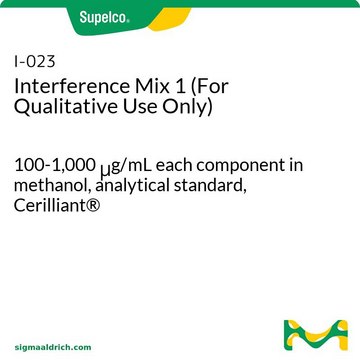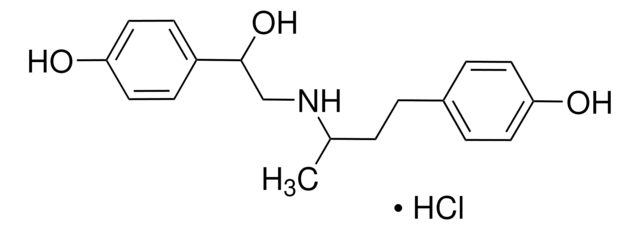I-028
Interference Mix 6
5-100 μg/mL each component in methanol, Cerilliant®
Synonim(y):
Qualitative Interference Mixture
About This Item
Polecane produkty
klasa czystości
analytical standard
Poziom jakości
Formularz
liquid
skład
Amlodipine besylate, 5 μg/mL (as free base)
Atorvastatin calcium salt, 100 μg/mL (as free base)
Azithromycin dihydrate, 100 μg/mL (as free base)
Bupivacaine hydrochloride monohydrate, 100 μg/mL (as free base)
Cetirizine dihydrochloride, 50 μg/mL (as free base)
Dimenhydrinate, 100 μg/mL
Lisinopril dihydrate, 100 μg/mL (as free base)
Loratadine, 100 μg/mL
opakowanie
ampule of 1 mL
producent / nazwa handlowa
Cerilliant®
stężenie
5-100 μg/mL each component in methanol
metody
gas chromatography (GC): suitable
liquid chromatography (LC): suitable
Zastosowanie
forensics and toxicology
Format
single component solution
temp. przechowywania
−20°C
Szukasz podobnych produktów? Odwiedź Przewodnik dotyczący porównywania produktów
Powiązane kategorie
Opis ogólny
Zastosowanie
- Densitometric HPTLC method for qualitative, quantitative analysis and stability study of Coenzyme Q10 in pharmaceutical formulations utilizing normal and reversed-phase silica gel plates.: Silica gel plates were used in HPTLC methods for analyzing Coenzyme Q10, demonstrating its application in pharmaceutical quality control and stability studies (Abdel-Kader et al., 2016).
- Development of an semi-automatic and sensitive photochemically induced fluorescence sensor for the determination of thiamethoxam in vegetables.: Silica gel was integral to the photochemical sensor′s development for detecting pesticide residues in vegetables, enhancing food safety testing (Jiménez-López et al., 2016).
- Flow injection amperometric sensor with a carbon nanotube modified screen printed electrode for determination of hydroquinone.: This research utilized silica gel in the modification of electrodes for the sensitive detection of hydroquinone, important for environmental monitoring and electrochemical analysis (Upan et al., 2016).
Informacje prawne
Hasło ostrzegawcze
Danger
Zwroty wskazujące rodzaj zagrożenia
Zwroty wskazujące środki ostrożności
Klasyfikacja zagrożeń
Acute Tox. 3 Dermal - Acute Tox. 3 Inhalation - Acute Tox. 3 Oral - Flam. Liq. 2 - STOT SE 1
Organy docelowe
Eyes,Central nervous system
Kod klasy składowania
3 - Flammable liquids
Klasa zagrożenia wodnego (WGK)
WGK 2
Temperatura zapłonu (°F)
49.5 °F - closed cup
Temperatura zapłonu (°C)
9.7 °C - closed cup
Wykazy regulacyjne
Wykazy regulacyjne dotyczą głównie produktów chemicznych. Można w nich podawać ograniczoną liczbę informacji na temat produktów niechemicznych. Brak wpisu oznacza, że żaden ze składników nie znajduje się w wykazie. Użytkownik odpowiada za zagwarantowanie bezpiecznego i zgodnego z prawem stosowania produktu.
EU REACH Annex XVII (Restriction List)
Wybierz jedną z najnowszych wersji:
Certyfikaty analizy (CoA)
It looks like we've run into a problem, but you can still download Certificates of Analysis from our Dokumenty section.
Proszę o kontakt, jeśli potrzebna jest pomoc Obsługa Klienta
Masz już ten produkt?
Dokumenty związane z niedawno zakupionymi produktami zostały zamieszczone w Bibliotece dokumentów.
Nasz zespół naukowców ma doświadczenie we wszystkich obszarach badań, w tym w naukach przyrodniczych, materiałoznawstwie, syntezie chemicznej, chromatografii, analityce i wielu innych dziedzinach.
Skontaktuj się z zespołem ds. pomocy technicznej











